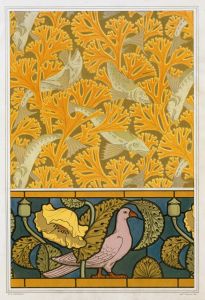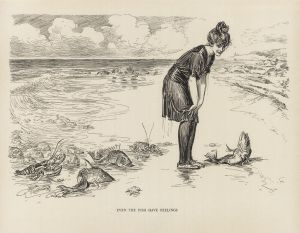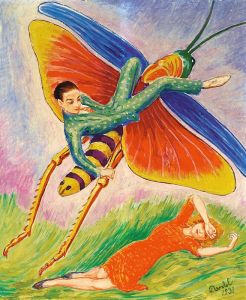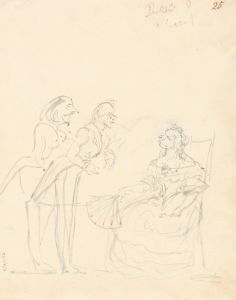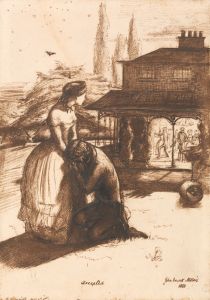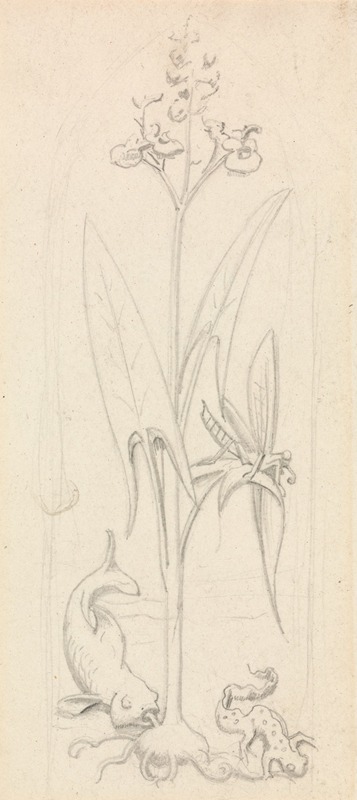
Stained Glass Study, Water Plant with Grasshoper, Fish and Newt
A hand-painted replica of Sir John Everett Millais’s masterpiece Stained Glass Study, Water Plant with Grasshoper, Fish and Newt, meticulously crafted by professional artists to capture the true essence of the original. Each piece is created with museum-quality canvas and rare mineral pigments, carefully painted by experienced artists with delicate brushstrokes and rich, layered colors to perfectly recreate the texture of the original artwork. Unlike machine-printed reproductions, this hand-painted version brings the painting to life, infused with the artist’s emotions and skill in every stroke. Whether for personal collection or home decoration, it instantly elevates the artistic atmosphere of any space.
"Stained Glass Study, Water Plant with Grasshopper, Fish and Newt" is a watercolor painting by Sir John Everett Millais, an influential English painter and illustrator who was one of the founding members of the Pre-Raphaelite Brotherhood. This artwork is notable for its intricate detail and naturalistic representation, characteristics that are hallmarks of the Pre-Raphaelite style.
The painting depicts a serene aquatic scene featuring a water plant, a grasshopper, a fish, and a newt. The composition is meticulously detailed, showcasing Millais's exceptional skill in rendering natural elements with precision and care. The water plant, likely a type of aquatic vegetation common in British waterways, is depicted with delicate leaves and stems, providing a lush backdrop for the other elements in the scene.
The grasshopper is portrayed perched on the plant, its form rendered with fine lines and a keen attention to the texture of its body and wings. The fish, swimming gracefully in the water, is depicted with a sense of movement and fluidity, its scales catching the light in a realistic manner. The newt, another aquatic creature, is shown in a lifelike pose, its skin and limbs carefully detailed to reflect its natural appearance.
Millais's use of watercolor in this study allows for a soft, luminous quality that enhances the natural beauty of the scene. The transparency of the medium enables the layering of colors, creating depth and a sense of realism. The artist's choice of subject matter reflects the Pre-Raphaelite interest in nature and the close observation of the natural world.
This work is a study, meaning it was likely created as a preparatory piece for a larger, more finished work or as an exercise in capturing the details of the natural elements. Studies like this were common practice among artists of the time, serving as a means to refine their techniques and explore different compositions.
Sir John Everett Millais (1829-1896) was a prominent figure in the Victorian art world. He was known for his contributions to the Pre-Raphaelite Brotherhood, a group of artists who sought to return to the detailed, vibrant, and complex compositions of early Renaissance art, before the influence of Raphael. Millais's work often featured themes of nature, beauty, and detailed realism, which are evident in "Stained Glass Study, Water Plant with Grasshopper, Fish and Newt."
The painting is part of the collection at the Ashmolean Museum in Oxford, which houses a significant number of works by Millais and other Pre-Raphaelite artists. The Ashmolean Museum is renowned for its extensive collection of art and antiquities, providing a comprehensive overview of various artistic movements and historical periods.
In summary, "Stained Glass Study, Water Plant with Grasshopper, Fish and Newt" by Sir John Everett Millais is a fine example of the artist's skill in watercolor and his dedication to the detailed observation of nature. It reflects the broader artistic goals of the Pre-Raphaelite Brotherhood and remains an important piece within the context of Victorian art.





